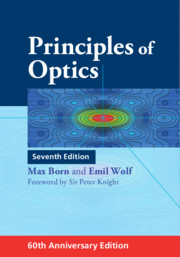Crossref Citations
This Book has been
cited by the following publications. This list is generated based on data provided by Crossref.
Hiraiwa, Toshihiko
Soutome, Kouichi
and
Tanaka, Hitoshi
2020.
Forced harmonic oscillator interpreted as diffraction of light.
Physical Review E,
Vol. 102,
Issue. 3,
So, Irina A.
Plachenov, Alexandr B.
and
Kiselev, Aleksei P.
2020.
Simple unidirectional finite-energy pulses.
Physical Review A,
Vol. 102,
Issue. 6,
Galuza, Alexey
Shkoda, Maryna
Tevyasheva, Olga
Belyaeva, Alla
Savchenko, Alla
and
Kolenov, Ivan
2020.
Modeling and Synthesis of Monochrome Interference Patterns of Flat Optical Surfaces With Typical Defects for Automatic Surface Quality Control.
p.
344.
Black, Peter
and
Black, Tina Arbon
2020.
Fundamentals of ophthalmic dispensing 10: Single vision lens design – part 1.
Optician,
Vol. 2020,
Issue. 7,
p.
8293-1.
Tsuchida, Satoshi
and
Kuratsuji, Hiroshi
2020.
Random motion theory of an optical vortex in nonlinear birefringent media.
Physical Review E,
Vol. 102,
Issue. 3,
2020.
Spoof Plasmons.
Bercioux, Dario
van den Berg, Tineke L.
Ferraro, Dario
Rech, Jérôme
Jonckheere, Thibaut
and
Martin, Thierry
2020.
Wave-particle duality of electrons with spin-momentum locking.
The European Physical Journal Plus,
Vol. 135,
Issue. 10,
Snyder, Joshua
Bailey, Christopher
Schmoll, Walter
Zuraski, Steven
and
Beecher, Elizabeth
2021.
Fringe visibility errors resulting from dual object imaging for stellar interferometers.
Applied Optics,
Vol. 60,
Issue. 25,
p.
G207.
Nikolov, Daniel K.
Bauer, Aaron
Cheng, Fei
Kato, Hitoshi
Vamivakas, A. Nick
and
Rolland, Jannick P.
2021.
Metaform optics: Bridging nanophotonics and freeform optics.
Science Advances,
Vol. 7,
Issue. 18,
Vartanyants, Ivan A.
and
Khubbutdinov, Ruslan
2021.
Theoretical analysis of Hanbury Brown and Twiss interferometry at soft-x-ray free-electron lasers.
Physical Review A,
Vol. 104,
Issue. 2,
Kuratsuji, Hiroshi
and
Tsuchida, Satoshi
2021.
Evolution of the Stokes parameters, polarization singularities, and optical skyrmion.
Physical Review A,
Vol. 103,
Issue. 2,
Sultan, Kamel S.
Mohammed, Beadaa
Manoufali, Mohamed
and
Abbosh, Amin M.
2021.
Portable Electromagnetic Knee Imaging System.
IEEE Transactions on Antennas and Propagation,
Vol. 69,
Issue. 10,
p.
6824.
Koutsioubas, Alexandros
2021.
anaklasis: a compact software package for model-based analysis of specular neutron and X-ray reflectometry data sets.
Journal of Applied Crystallography,
Vol. 54,
Issue. 6,
p.
1857.
Li, Xiao
Li, Pengqi
Lu, Ming-Hui
Fink, Mathias
and
Ma, Guancong
2021.
Negative Transient Flux in the Near Field of a Subwavelength Source.
Physical Review Applied,
Vol. 16,
Issue. 1,
Malhotra, Isha
and
Singh, Ghanshyam
2021.
Terahertz Antenna Technology for Imaging and Sensing Applications.
p.
217.
Derevtsov, E. Yu.
2021.
On a Generalization of Exponential Ray Transform in Tomography.
Journal of Mathematical Sciences,
Vol. 253,
Issue. 3,
p.
369.
Blahnik, Vladan
and
Schindelbeck, Oliver
2021.
Smartphone imaging technology and its applications.
Advanced Optical Technologies,
Vol. 10,
Issue. 3,
p.
145.
Kaganer, Vladimir M.
Petrov, Ilia
and
Samoylova, Liubov
2021.
Resolution of a bent-crystal spectrometer for X-ray free-electron laser pulses: diamond versus silicon.
Acta Crystallographica Section A Foundations and Advances,
Vol. 77,
Issue. 4,
p.
268.
Paramonov, Pavel
Lumbeeck, Lars-Paul
Sijbers, Jan
and
De Beenhouwer, Jan
2021.
A study of terahertz beam simulation with ray tracing for computed tomography.
p.
JTu5A.37.
Sung, Yongjin
2021.
Snapshot Three-Dimensional Absorption Imaging of Microscopic Specimens.
Physical Review Applied,
Vol. 15,
Issue. 6,





